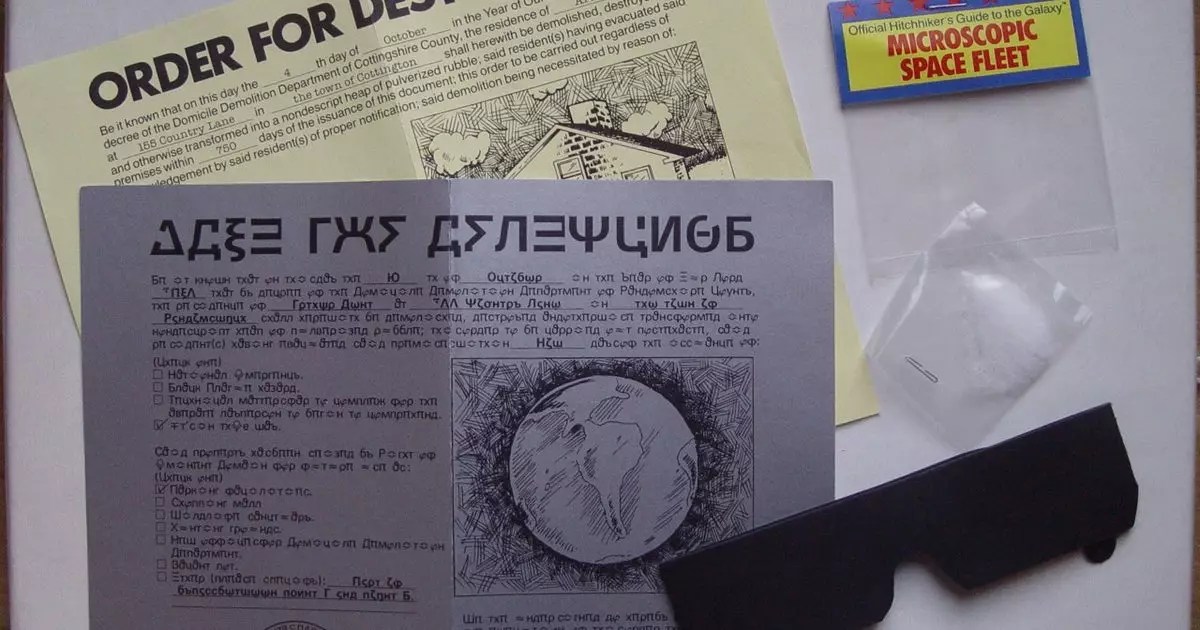The world of gaming has undergone a tremendous transformation since its inception, evolving from pixelated graphics and rudimentary storylines to sprawling narratives combined with stunning visuals. Among the key players in this evolution is Infocom, a company that stood apart in the 1980s not merely for its text-based adventures but for its inclusion of physical items in gaming packages—affectionately termed “feelies.” This innovation, brought to life in the 1984 classic adventure game “The Hitchhiker’s Guide to the Galaxy,” represented more than mere marketing; it embodied a philosophy of interaction and engagement that modern gaming often neglects.
The delight of “feelies” is found in their sheer impracticality. These physical objects—such as a packet filled with a label purporting to contain something invisible—quickly became a hallmark of Infocom’s releases. In an age where video games tend to bombard players with information and collectibles designed to enhance gameplay, Infocom’s approach feels refreshingly simple, if not utterly charming. By including something that serves little function other than to evoke a sense of wonder or curiosity, Infocom managed to forge a connection with its audience that went beyond the confines of the screen.
Arthur Dent: A Protagonist for the Ages
But what truly sets Infocom’s “The Hitchhiker’s Guide to the Galaxy” apart is its protagonist, Arthur Dent. In her compelling analysis, Victoria Regan paints a picture of Dent that resonates deeply in the chaotic world we inhabit. Traditionally seen as the bumbling everyman, Arthur serves as a representation of the ordinary citizen confronting an absurd universe. Regan’s interpretation that his defensive stance against the overwhelming randomness of life signifies a unique brand of courage reframes our understanding of heroism. Unlike the valiant warriors often celebrated in today’s gaming narrative, Dent’s lack of bravado showcases a form of heroism that is relatable and genuine.
Regan’s perspective encourages us to see the layers of Dent’s character that we may have overlooked. His willingness to lay down in front of a bulldozer is not merely a comedic scene; it is a profound metaphor for human resilience in the face of existential absurdity. In a world where the stakes are often paralleled with grand battles and mythical quests, Arthur’s small, yet significant decisions serve to remind us that our everyday struggles can be heroic in their persistence and vulnerability.
The Quest for Discovery Amidst the Digital Clutter
One of Regan’s most poignant points is the drive that kept her and her brother engaged with the famously challenging adventure game: the desire to uncover hidden treasures within the narrative. In an age defined by spoilers, strategies, and pre-released gameplay footage, this yearning for discovery has faded. Modern gaming is often packaged within a commercial framework that lays out experiences before we even begin to play, stripping away the nuances of personal interpretation and individual journey that characterized earlier titles like “The Hitchhiker’s Guide.”
The anticipation of uncovering secrets transforms gameplay into a quest for knowledge, a stark contrast to the present landscape where games feel like scripted paths lined with advertisements and predetermined hype. As we navigate contemporary titles that are polished to gleam with promotional brilliance, it’s imperative to remember the joy found in exploration—the thrill of not knowing what awaits us around the corner.
The Relevance of Uselessness in a Collectible Market
The proliferation of video game collectibles has led to a streamlined and, dare I say, stale approach to fandom. Statues and figurines dominate the landscape, designed to appeal to a market that prioritizes visual spectacle over an emotional connection to the content itself. Infocom’s feelies, in their delightful uselessness, challenge the standardization of collectibles. They represent an era of gaming where what was included served to engage and amuse rather than to inflate the value of a product.
There’s something beautifully ironic about “useless” items—their very ineffectiveness is a conversation starter and a source of laughter. As we gravitate towards sleek, marketable collectibles that promise recognition and status among peers, perhaps we should seek out more of those humble artifacts that invite introspective connections and playful interactions.
Embracing the charm of the unnecessary can remind us of the whimsical nature of gaming. It highlights our innate desire for serendipity, which has become increasingly rare in today’s hyper-competitive environment. The enjoyment of games should encompass more than mere achievements; it should celebrate the wonder of the unpredictable. In a world craving authenticity and human connection, revisiting the humble feelies of Infocom is not only nostalgic but necessary.


Leave a Reply